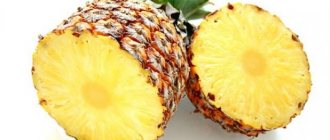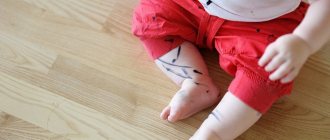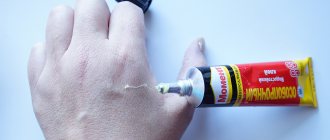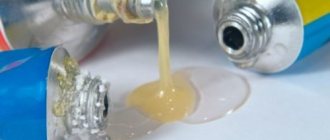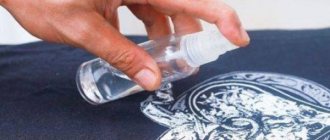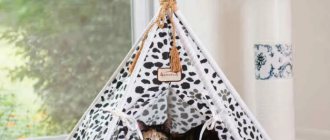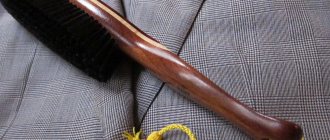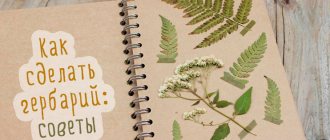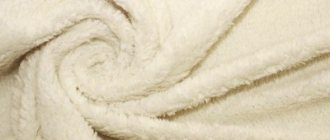You can clean clothes from any glue, starting with stationery PVA and ending with “Moment” or one-second “Superglue”. The main thing is to adhere to a certain algorithm of actions. Otherwise, there is a possibility of damaging the tissue structure so that it cannot be restored.
Clothes stained with glue Source dekoriko
Advantages of hot-melt adhesive and its types
The thermal composition does not need to be mixed before application and is easy to store after use. It has a long shelf life. Such compositions have good adhesion to any surface. After application, they form a dense, durable seam, connecting different structures into one.
Hot melt adhesive is used to join the following materials:
- paper of various densities, including cardboard;
- almost all types of plastics;
- glass;
- metal surfaces;
- wood;
- fabrics and others.
Hot-melt adhesive has low consumption, there is no need to clean the tool, the glue gun allows you to carry out work accurately. But sometimes its traces remain where they are not expected at all: on the floor, clothes, skin, equipment.
There are special compounds for removing hot-melt adhesive. To do this, it is important to follow the recommendations on the packaging. Before choosing a glue remover, you should clarify what substance it is based on.
There are several types of hot melt adhesive:
- polyamide;
- EVA or ethylene vinyl acetate;
- polyester;
- polyolefin;
- silicone based;
- based on rubber (synthetic);
- reactive polyurethane.
Each material has its own physical and chemical characteristics and is dissolved in different solvents. Most glue sticks are dissolved by acids and alkalis. But these aggressive substances can damage or even destroy the bonded surfaces. There are funds for building materials, but with hot-melt adhesive you will need a lot of them, and the process itself will take quite a lot of time.
Hot-melt adhesives are hazardous to health if the room is poorly ventilated during operation. You can get burns to your respiratory tract.
PVA
If you or your child accidentally dropped polyvinyl acetate emulsion onto clothing, do not worry ahead of time, as you can wash PVA glue from clothing without problems. The substance has a water-soluble composition, so there should be no difficulties in removing stains.
The action plan will be like this:
- It is necessary to wipe the stain with a sponge soaked in alcohol or vinegar.
- Soak the item in water with added powder.
- After which it is good to wash.
An alternative to this option is to use laundry soap and a brush. For convenience, you can take an old toothbrush that is no longer used. If the stain is old or has simply dried out, you need to soak it in table vinegar and then rub it with a brush.
Advice! Different materials and fabrics may behave unpredictably when removing glue. Therefore, before removing PVA glue from any material, you need to conduct a vinegar test on an inconspicuous area of clothing.
You can remove remnants of PVA glue from linen fabric with one sponge soaked in alcohol.
It will be useful to know how to remove glue from suede using steam. It is necessary to expose the steam for 3 minutes, after which the stain will begin to soften, and it can be wiped off with a napkin.
Those for whom it is important to know how to wash office glue will need a similar principle of action as with PVA. Since this type of glue is also made on the basis of aqueous sodium silicate, it is enough to rinse it off with warm water.
From fabric
Liquid cleaner works great for most types of hot melt adhesive. It can be removed by soaking a cotton pad in this liquid and applying it to the seam. After a few minutes, the glue can be removed with a dry cloth. This method has proven its effectiveness many times.
Isopropyl alcohol, available at hardware stores, may help. Before wiping off the glue, it is worth testing its effect on a small area in an inconspicuous place (seams, hem on the wrong side). To clean hot melt adhesive, you can use the following procedure:
- Shake the container well, mix all the layers;
- apply a small amount of the composition to the seam (using a cloth or spraying);
- Allow the chemical reaction to take place for a few minutes (no vapors or other manifestations);
- wipe the seam with a damp cloth;
- if the result is not good enough, the entire procedure should be repeated.
Isopropyl alcohol has a moderate level of toxicity and is a flammable liquid. Prolonged inhalation of its vapors can cause poisoning and dizziness. The substance requires careful handling.
Gasoline, acetone or white spirit can also dissolve the glue, but it will take some effort and time to remove all the adhesive. These substances can damage bonded surfaces.
If the glue is completely dry, you can dilute vinegar in a ratio of 1 tablespoon to a liter of clean water. Soak the item in liquid for 40-60 minutes. Then wash the item in hot water with soap and stain remover.
What to do if the glue has dried?
Dealing with already dried superglue stains is much more difficult, but you can try:
- Scrape them off with a not too sharp knife. As a rule, it is not possible to completely get rid of the adhesive stain in this way. Residual traces of superglue can be permanently removed by washing.
- Break them with several blows of a hammer, laying the damaged item on a hard surface. This method is suitable for removing drops of superglue that have frozen on clothing in the form of large peas. The crumbled particles of the adhesive stain are carefully separated, and the clothes are washed immediately using laundry soap and hot water.
From knitted jersey
Some types of hot melt adhesive are not resistant to negative temperatures. This should be indicated in the instructions for use. It is necessary to wait until the glue has completely dried, and only then begin to remove it from a hat, sweater or other knitted fabric. When hot, the glue dries very quickly, but at sub-zero temperatures it becomes brittle and can be removed from the surface very well.
Place the stained fabric in the freezer until the glue freezes completely and becomes brittle. Then, using a spoon or other hard object, the glue crumbles and is easily removed from the fabric. After this, it is recommended to wash and rinse the item.
Cleaning traces of rhinestones
Rhinestones are usually glued to jeans with hot glue and it is very difficult to remove. On the fabric, when decorative elements fall off, gray-yellowish spots remain, which spoil the appearance of the clothing. This problem can be solved in different ways.
Place the jeans on the ironing board and lay a cloth or napkin over them. Then use the hot sole of the iron to go over the areas with glue. At high temperatures, the glue will begin to melt and stick to the napkin.
Glue stains can be removed from white clothes with solvent or nail polish remover. This method is only suitable for white and light-colored fabrics; colored fabrics should not be processed using this method, as the paint can be damaged.
Universal methods against dried stains
Various types of fabric are susceptible to stains. Previously, methods were listed that told how to wash off glue using homemade means, including old and stubborn stains of adhesives. In most cases, white spirit, acetone and gasoline are used. It is worth considering that these liquids can react poorly on fabrics, and sometimes even react with paint. If the item is dear to the owner, you should give it to professionals, dry cleaning. Workers in this field are experts and know the intricacies of how to remove glue from trousers, sweaters, dresses and even jackets. By entrusting the item to them, you can be confident in the outcome of the activities carried out.
Rate this post
From the carpet
Place a cloth or paper napkin on the glue stain. When hot, the adhesive composition is well absorbed from the surface of the carpet. Using a heated iron at medium power, press the area of the stained area.
The iron should fit snugly to the fabric. You cannot move it back and forth, otherwise the problem will only worsen. This will only spread the glue further across the carpet, causing the stain to spread over a larger area.
It is better to use rubber or disposable gloves to avoid getting your hands dirty. It is not recommended to touch the hot surface of the carpet with your fingers; you may get burned.
If not all the glue was removed from the carpet the first time, the procedure must be repeated again with a new napkin. After ironing, the contaminated area should be thoroughly wiped with a carpet cleaner to remove unnoticeable particles of glue.
From the board surface
Cold cleaner is used to remove hot melt adhesive from smooth surfaces such as processors, boards or other equipment. They can be in liquid form and sold in bottles, sprays and cans. This composition is applied to the contaminated area, and then wiped with a rag or napkin.
Before use, check for material compatibility. Do not spray such sprays near fire sources or hot objects. It is important to strictly follow the manufacturer's recommendations specified in the instructions for use.
Questions and answers
How to remove hot melt glue using an iron?
Place a piece of cloth or paper napkin on the dirty surface of the ironing board. Using a heated iron, iron the area stained with adhesive. Cover the area from above with another flap and heat it again with an iron for 10-20 seconds, remove the iron from the surface. Repeat the manipulation until all the glue from the clothing has transferred to the napkin or piece of fabric.
How to remove hot glue from a wooden tabletop?
Glue is wiped off wooden surfaces with 70-90% alcohol. Moisten the trace of hot-melt glue generously, leave for 10 minutes, then wipe with a damp, clean cloth. To avoid wood defects, try first in an inconspicuous place.
In its normal state, hot-melt adhesive hardens in air, penetrating the fabric structure. Penetration depth is the main problem in removing adhesive stains. To completely get rid of it, in some cases you will have to combine several methods or repeat the manipulations several times.
How can you remove glue stains at home?
Universal solvents are compounds that help get rid of all types of glue, regardless of their origin. They must be used carefully, since they are based on caustic substances.
An effective, inexpensive and effective product is “Super Moment Anti-Glue”, which costs about 100 rubles per package. It copes not only with removing adhesive stains from Superglue, but also with other adhesives: PVA, contact adhesives, etc.
The product has a gel consistency, thanks to which it does not spread over the surface of the fabric and does not stain clothes.
Mode of application:
- Place a paper napkin under the back of the soiled item.
- Apply the composition to the stain.
- Cover it on top with another napkin and leave overnight.
- Put away napkins, wash things.
Other universal compositions include:
- Acetone. The substance has a pungent odor, so it should only be used in areas with good ventilation. To avoid damaging the fabric, first test the product on an inconspicuous area. Moisten a cotton pad with acetone and use it to treat the stain. You cannot leave it on the fabric for a long time.
- Nail polish remover . It contains acetone, but in a lower concentration, so when removing traces of persistent glue, it can be left on the item for 10-15 minutes. Remove dirt using a stiff brush, for example, the back of a sponge.
- Petrol. It has a fatty base and a pungent odor. Therefore, it is recommended to use it outdoors. The composition is applied to gauze folded in several layers, which is used to systematically treat stains on clothing.
- Dimexide. This is a pharmaceutical solution that is used for medicinal purposes. To remove sticky traces you will need a 99% concentrate. To remove fresh stains, simply apply Dimexide to a napkin. It wipes away the dirt until it disappears completely. If the glue has dried, make a lotion, keeping the solution on the fabric for no longer than 5-15 minutes.
All universal compositions are capable of dissolving not only glue molecules, but also paint. Therefore, when processing colored fabrics, you need to test the selected product on an inconspicuous area.

